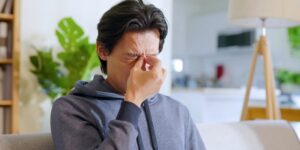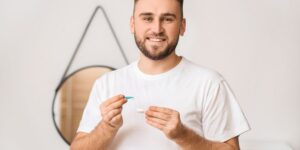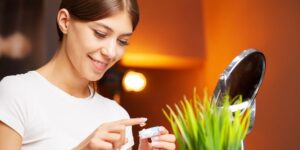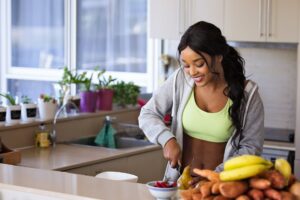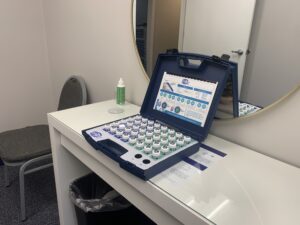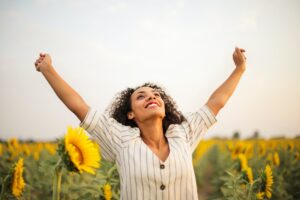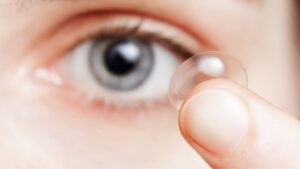Scleral lenses are a type of contact lens that are larger in diameter compared to traditional contact lenses. They cover the entire cornea and rest on the white part of the eye, called the sclera. These lenses are specially designed to treat various eye conditions such as keratoconus, dry eyes, corneal irregularities, and post-surgical complications.
Unlike regular contact lenses, scleral lenses have a unique design that vaults over the cornea and creates a tear-filled reservoir between the lens and the eye. This reservoir helps to protect the cornea, providing relief from discomfort and allowing for improved vision. Scleral lenses are custom-made to fit each individual’s eye shape and can be an effective solution for those who struggle with traditional contact lenses or glasses.
The lifespan of scleral lenses varies depending on several factors, including the wearer’s cleaning routine, wearing schedule, and individual eye characteristics. On average, scleral lenses can last anywhere from six months to two years, with proper care and maintenance. However, it is essential to have regular follow-up visits with an eye care professional, such as Dr. Kresch at Michigan contact Lens, to assess the condition of the lenses and evaluate any changes in prescription or fit.
Cleaning scleral lenses is crucial to maintain their longevity and ensure proper eye health. Here is a recommended cleaning routine for scleral lenses:
1. Wash your hands thoroughly with a mild, fragrance-free soap and dry them with a lint-free towel.
2. Fill the lens case with a preservative-free saline solution or a recommended lens disinfecting solution. Our go-to solutions are either LacriPure or ScleralFil.
3. Remove the lens from your eye and place it in the palm of your hand.
4. Apply a few drops of a recommended cleaning solution onto the lens surface.
5. Gently rub the lens in a circular motion using your index finger to remove any debris or protein deposits.
6. Rinse the lens thoroughly with saline solution to remove any remaining cleaning solution.
7. Place the lens in the clean lens case and fill it with disinfecting solution.
8. Repeat the process for the other lens.
Always follow the specific cleaning instructions provided by your contact lens specialist and utilize recommended products to ensure the best results. Avoid using tap water or homemade solutions, as they can potentially cause eye infections or damage to the lenses.
The maximum wear time for scleral lenses should be determined by your eye care professional based on your eye health and individual needs. Typically, most people can wear scleral lenses for 10-12 hours a day. However, this can vary depending on factors such as discomfort, dryness, or any underlying eye conditions. It is important to follow your eye care professional’s instructions regarding the recommended wear time and to never exceed the prescribed duration.
Typically, when starting out, we request the lenses to be worn for only a few hours a day, and gradually increase the number of hours over time.
The cost of scleral lenses can vary depending on various factors, including the region, eye care professional, and specific lens requirements. Generally, scleral lenses tend to be much more expensive than traditional contact lenses due to their custom-made nature and specialized design. On average, the cost of scleral lenses can range from $1200 to $2,500 per lens. The cost includes the fitting process, lens customization, professional fees, and follow-up care. It is important to consult with your eye care professional to get an accurate estimate based on your specific needs and location. At Michigan Contact Lens, we separate the fitting charge with the cost of the lenses to make the cost of the scleral lens process more palatable.
Inserting scleral lenses requires practice and proper technique. Here is a step-by-step guide on how to insert scleral lenses:
1. Wash your hands thoroughly with mild, fragrance-free soap and dry them with a lint-free towel.
2. Fill the lens with a preservative-free saline solution.
3. Place the lens on the inserter. We recommend the DMV inserters.
4. Use your fingers to hold your upper eyelid and the thumb to hold your lower eyelid open.
5. Look directly at the lens and gently place it onto your eye, making sure to avoid blinking during this step.
6. Release your eyelids slowly, allowing the lens to center on your eye.
7. Use your index finger to apply slight pressure on the lens to ensure it is firmly in place.
8. Blink gently a few times to help settle the lens and ensure clear vision.
Remember, practice makes perfect when it comes to inserting scleral lenses. If you are having difficulty, don’t hesitate to consult with your eye care professional, who can provide additional guidance and support.
Scleral lenses can provide excellent comfort for many individuals, as they offer a smooth and stable fit on the eye. The saline-filled reservoir between the lens and the cornea helps to soothe dry eyes and reduces friction that can cause discomfort. Moreover, the larger diameter of scleral lenses prevents them from touching the sensitive cornea, making them more comfortable compared to traditional contact lenses.
However, comfort can vary from person to person. Some individuals may experience initial discomfort or a sensation of having a foreign object in their eye when first wearing scleral lenses. This is typically due to the adaptation period as your eyes get used to the lenses. It is essential to follow your contact lens specialist’s instructions, attend regular follow-up appointments, and communicate any discomfort or concerns you experience during the fitting process.
Yes, scleral lenses are made from gas permeable materials. This means that oxygen can pass through the lens material and reach the cornea, ensuring adequate oxygen supply for the health of your eyes. The gas permeability of scleral lenses allows for better overall eye health and reduces the risk of complications often associated with traditional hard lenses, such as corneal hypoxia or swelling.
Scleral lenses are designed to allow oxygen to flow freely under the lens, maintaining corneal health and comfort throughout the day. However, it is crucial to follow the recommended wearing and care instructions to ensure optimal oxygen permeability and minimize potential risks.
Scleral lenses are classified as hard lenses due to their rigid material. Unlike soft contact lenses, which are made of flexible and pliable materials, scleral lenses retain their shape on the eye, providing a more stable and consistent vision. The rigid nature of scleral lenses allows for better correction of irregular corneas and provides a smooth optical surface, resulting in improved visual acuity.
While rigid, scleral lenses are designed to fit comfortably on the eye and provide adequate tear exchange, minimizing lens awareness and discomfort. The combination of rigid materials and a well-fit design allows scleral lenses to offer clear vision and enhanced comfort for those who require specialty contact lenses.
When used properly and under the guidance of an eye care professional, scleral lenses are generally safe and well-tolerated. However, improper handling, care, or misuse of scleral lenses can lead to potential complications or eye health issues. It is essential to follow the recommended guidelines for wearing, cleaning, and storing the lenses to minimize any risks.
Some potential risks associated with scleral lenses include eye infections, corneal abrasions, allergic reactions, or discomfort. These risks can be minimized by strict adherence to hygiene practices, regular follow-up visits, and promptly reporting any discomfort or concerns to your eye care professional.
It is important to consult with a qualified contact lens doctor to determine if scleral lenses are suitable for your individual needs and to receive proper fitting, education, and ongoing care.
Scleral lenses are a type of contact lens that are larger in size and cover not only the cornea but also the entire sclera, (the white part of the eye). They are often recommended for individuals with certain eye conditions where regular contact lenses or glasses are inadequate. These conditions include keratoconus, irregular astigmatism, corneal ectasia, severe dry eye syndrome, and other corneal irregularities.
For individuals with these conditions, scleral lenses can be medically necessary. Traditional contact lenses may not provide the needed stability or comfort, and glasses may not correct the refractive error adequately. Scleral lenses create a smooth and regular optical surface, allowing for clearer vision while also protecting the cornea.
Yes, scleral lenses are a type of rigid gas permeable (RGP) lens. RGP lenses are made of a hard and oxygen-permeable material, allowing proper oxygen flow to the cornea. This material enhances comfort and maintains the health of the eye. Scleral lenses are specifically designed to vault over the cornea and rest on the sclera, making them different from traditional smaller RGP lenses that sit directly on the cornea.
Scleral lenses are generally considered extremely safe as long as they’re used correctly and under the supervision of a contact lens specialist. Proper fitting and follow-up care are crucial to ensuring safety and optimal vision. The process of obtaining scleral lenses includes a comprehensive eye examination, corneal topography, and careful measurements to customize the lenses for a perfect fit. Regular check-ups and adjustments are necessary to prevent any issues such as discomfort, irritation, or corneal complications.
It is important to note that any contact lens carries some risk if not used correctly. Proper hygiene, cleaning, and storage are essential to reduce the risk of infection or other complications. Following the instructions and recommendations provided by your scleral lens specialist is crucial for safe and successful use of scleral lenses.
Yes, eye drops can be used with scleral lenses. In fact, using lubricating eye drops or artificial tears is often recommended to enhance comfort and keep the eyes hydrated when wearing scleral lenses. Since scleral lenses create a reservoir of fluid between the lens and the cornea, using eye drops can help replenish moisture and alleviate symptoms of dryness or irritation.
It is important to note that not all eye drops are suitable for use with scleral lenses. It is recommended to consult with your optometrist to determine which eye drops are compatible and safe to use with your specific type of lens.
Scleral lenses are made of durable and rigid materials, so they don’t tear like soft contact lenses. However, they are not indestructible, and certain factors can lead to lens damage. Rough handling, dropping the lenses on hard surfaces, or using inappropriate cleaning solutions can potentially cause cracks or breaks in the lens.
It is essential to handle scleral lenses with care, following the specific instructions provided by your eye care professional. Using a lens care system designed for rigid gas permeable lenses and avoiding exposure to sharp objects or extreme temperatures can help prevent lens damage.
When used properly and under the guidance of an optometrist, scleral lenses should not damage your eyes. In fact, scleral lenses can provide significant benefits to individuals with certain eye conditions, improving vision and comfort.
However, if scleral lenses are not fitted correctly or not properly maintained, they can potentially cause eye complications. Poorly fitted lenses can lead to corneal abrasions, discomfort, or even infections. It is crucial to work with an experienced eye care professional who can ensure a proper fit, provide detailed instructions on lens care and hygiene, and monitor the health of your eyes regularly.
In general, sleeping in scleral lenses is not recommended unless specifically prescribed and approved by your eye care professional. Sleeping in contact lenses reduces the amount of oxygen reaching the cornea and increases the risk of complications such as corneal swelling, dryness, irritation, or even infections. Extended wear lenses, which are designed for continuous overnight wear, are available, but they should only be used under professional supervision.
It is important to follow the instructions provided by your eye care professional regarding the wear schedule and maintenance of your scleral lenses. Removing the lenses before sleep allows your eyes to receive the necessary oxygen and reduces the risk of potential complications.
It is generally not recommended to nap in scleral lenses. Sleeping in contact lenses, including scleral lenses, increases the risk of complications such as corneal swelling, reduced oxygen supply to the cornea, and increased risk of infection. Moreover, there is a higher chance of accidentally dislodging the lenses during sleep, leading to discomfort or difficulties in reinserting them.
If you regularly take naps or plan to sleep during the day, it is advisable to remove your scleral lenses beforehand and store them properly in the recommended lens solution. This will allow your eyes to rest and recover during sleep, reducing the risk of potential complications associated with prolonged lens wear.
It is generally not recommended to shower while wearing scleral lenses. While the lenses create a protective barrier between your eyes and the surrounding environment, water exposure during showering can still pose potential risks. Water from the shower, especially if it is not clean or contains microorganisms, can get trapped behind the lenses and increase the risk of infections.
To minimize this risk, it is advisable to remove the scleral lenses before showering. If you have concerns about your vision during showering, consider using prescription swim goggles or consult with your eye care professional for alternative recommendations.
It is generally not recommended to swim while wearing scleral lenses. Swimming pools, hot tubs, lakes, and oceans contain various microorganisms and potential irritants that can penetrate behind the lenses, increasing the risk of infections or other complications.
If you enjoy swimming, it is advisable to remove your scleral lenses before entering the water. Wearing prescription swim goggles can provide clear vision and protect your eyes during swimming. However, it is crucial to consult with your scleral lens doctor for specific recommendations tailored to your individual needs and eye condition.
What are scleral lenses?
Scleral lenses are a type of contact lens that are larger in diameter compared to traditional contact lenses. They cover the entire cornea and rest on the white part of the eye, called the sclera. These lenses are specially designed to treat various eye conditions such as keratoconus, dry eyes, corneal irregularities, and post-surgical complications.
Unlike regular contact lenses, scleral lenses have a unique design that vaults over the cornea and creates a tear-filled reservoir between the lens and the eye. This reservoir helps to protect the cornea, providing relief from discomfort and allowing for improved vision. Scleral lenses are custom-made to fit each individual’s eye shape and can be an effective solution for those who struggle with traditional contact lenses or glasses.
How long do scleral lenses last?
The lifespan of scleral lenses varies depending on several factors, including the wearer’s cleaning routine, wearing schedule, and individual eye characteristics. On average, scleral lenses can last anywhere from six months to two years, with proper care and maintenance. However, it is essential to have regular follow-up visits with an eye care professional to assess the condition of the lenses and evaluate any changes in prescription or fit.
How to clean scleral lenses?
Cleaning scleral lenses is crucial to maintain their longevity and ensure proper eye health. Here is a recommended cleaning routine for scleral lenses:
1. Wash your hands thoroughly with a mild, fragrance-free soap and dry them with a lint-free towel.
2. Fill the lens case with a preservative-free saline solution or a recommended lens disinfecting solution.
3. Remove the lens from your eye and place it in the palm of your hand.
4. Apply a few drops of a recommended cleaning solution onto the lens surface.
5. Gently rub the lens in a circular motion using your index finger to remove any debris or protein deposits.
6. Rinse the lens thoroughly with saline solution to remove any remaining cleaning solution.
7. Place the lens in the clean lens case and fill it with fresh saline or disinfecting solution.
8. Repeat the process for the other lens.
Always follow the specific cleaning instructions provided by your eye care professional and utilize recommended products to ensure the best results. Avoid using tap water or homemade solutions, as they can potentially cause eye infections or damage to the lenses.
How long can you wear scleral lenses in a day?
The maximum wear time for scleral lenses should be determined by your eye care professional based on your eye health and individual needs. Typically, most people can wear scleral lenses for 10-12 hours a day. However, this can vary depending on factors such as discomfort, dryness, or any underlying eye conditions. It is important to follow your eye care professional’s instructions regarding the recommended wear time and to never exceed the prescribed duration.
How much do scleral lenses cost?
The cost of scleral lenses can vary depending on various factors, including the region, eye care professional, and specific lens requirements. Generally, scleral lenses tend to be more expensive than traditional contact lenses due to their custom-made nature and specialized design. On average, the cost of scleral lenses can range from $500 to $2,500 per lens. This cost includes the fitting process, lens customization, professional fees, and follow-up care. It is important to consult with your eye care professional to get an accurate estimate based on your specific needs and location.
How to insert scleral lenses?
Inserting scleral lenses requires practice and proper technique. Here is a step-by-step guide on how to insert scleral lenses:
1. Wash your hands thoroughly with mild, fragrance-free soap and dry them with a lint-free towel.
2. Fill the lens bowl with a preservative-free saline solution or a recommended insertion solution.
3. Place the lens on the tip of the index finger of your non-dominant hand.
4. Use the middle finger of the same hand to hold your upper eyelid and the thumb to hold your lower eyelid open.
5. Look directly at the lens and gently place it onto your eye, making sure to avoid blinking during this step.
6. Release your eyelids slowly, allowing the lens to center on your eye.
7. Use your index finger to apply slight pressure on the lens to ensure it is firmly in place.
8. Blink gently a few times to help settle the lens and ensure clear vision.
Remember, practice makes perfect when it comes to inserting scleral lenses. If you are having difficulty, don’t hesitate to consult with your eye care professional, who can provide additional guidance and support.
How to put scleral lenses in?
Putting scleral lenses in requires a similar process to inserting them. Follow these steps to put scleral lenses in:
1. Wash your hands thoroughly with mild, fragrance-free soap and dry them with a lint-free towel.
2. Fill the lens bowl with a preservative-free saline solution or a recommended insertion solution.
3. Place the lens on the tip of the index finger of your non-dominant hand.
4. Use the middle finger of the same hand to hold your upper eyelid and the thumb to hold your lower eyelid open.
5. Look downward and gently place the lens onto your eye, aiming towards the lower part of the eye.
6. Gradually release your eyelids, ensuring the lens is centered on your eye.
7. Use your index finger to apply slight pressure on the lens to ensure it is firmly in place.
8. Blink gently a few times to help settle the lens and ensure clear vision.
As with inserting scleral lenses, if you are having difficulties with the process, seek advice from your eye care professional for additional guidance.
Are scleral lenses comfortable?
Scleral lenses can provide excellent comfort for many individuals, as they offer a smooth and stable fit on the eye. The tear-filled reservoir between the lens and the cornea helps to soothe dry eyes and reduces friction that can cause discomfort. Moreover, the larger diameter of scleral lenses prevents them from touching the sensitive cornea, making them more comfortable compared to traditional contact lenses.
However, comfort can vary from person to person. Some individuals may experience initial discomfort or a sensation of having a foreign object in their eye when first wearing scleral lenses. This is typically due to the adaptation period as your eyes get used to the lenses. It is essential to follow your eye care professional’s instructions, attend regular follow-up appointments, and communicate any discomfort or concerns you experience during the fitting process.
Are scleral lenses gas permeable?
Yes, scleral lenses are made from gas permeable materials. This means that oxygen can pass through the lens material and reach the cornea, ensuring adequate oxygen supply for the health of your eyes. The gas permeability of scleral lenses allows for better overall eye health and reduces the risk of complications often associated with traditional hard lenses, such as corneal hypoxia or swelling.
Scleral lenses are designed to allow oxygen to flow freely under the lens, maintaining corneal health and comfort throughout the day. However, it is crucial to follow the recommended wearing and care instructions to ensure optimal oxygen permeability and minimize potential risks.
Are scleral lenses hard or soft?
Scleral lenses are classified as hard lenses due to their rigid gas permeable (RGP) material. Unlike soft contact lenses, which are made of flexible and pliable materials, scleral lenses retain their shape on the eye, providing a more stable and consistent vision. The rigid nature of scleral lenses allows for better correction of irregular corneas and provides a smooth optical surface, resulting in improved visual acuity.
While rigid, scleral lenses are designed to fit comfortably on the eye and provide adequate tear exchange, minimizing lens awareness and discomfort. The combination of rigid materials and a well-fit design allows scleral lenses to offer clear vision and enhanced comfort for those who require specialty contact lenses.
Are scleral lenses dangerous?
When used properly and under the guidance of an eye care professional, scleral lenses are generally safe and well-tolerated. However, improper handling, care, or misuse of scleral lenses can lead to potential complications or eye health issues. It is essential to follow the recommended guidelines for wearing, cleaning, and storing the lenses to minimize any risks.
Some potential risks associated with scleral lenses include eye infections, corneal abrasions, allergic reactions, or discomfort. These risks can be minimized by strict adherence to hygiene practices, regular follow-up visits, and promptly reporting any discomfort or concerns to your eye care professional.
It is important to consult with a qualified eye care professional to determine if scleral lenses are suitable for your individual needs and to receive proper fitting, education, and ongoing care.
Are scleral lenses medically necessary?
Scleral lenses are a type of contact lens that are larger in size and cover not only the cornea but also the entire sclera, or the white part of the eye. They are often recommended for individuals with certain eye conditions where regular contact lenses or glasses are inadequate. These conditions include keratoconus, irregular astigmatism, corneal ectasia, severe dry eye syndrome, and other corneal irregularities.
For individuals with these conditions, scleral lenses can be medically necessary. Traditional contact lenses may not provide the needed stability or comfort, and glasses may not correct the refractive error adequately. Scleral lenses create a smooth and regular optical surface, allowing for clearer vision while also protecting the cornea.
Are scleral lenses RGP?
Yes, scleral lenses are a type of rigid gas permeable (RGP) lens. RGP lenses are made of a hard and oxygen-permeable material, allowing proper oxygen flow to the cornea. This material enhances comfort and maintains the health of the eye. Scleral lenses are specifically designed to vault over the cornea and rest on the sclera, making them different from traditional smaller RGP lenses that sit directly on the cornea.
Are scleral lenses safe?
Scleral lenses are generally considered safe when used correctly and under the supervision of an eye care professional. Proper fitting and follow-up care are crucial to ensuring safety and optimal vision. The process of obtaining scleral lenses includes a comprehensive eye examination, corneal topography, and careful measurements to customize the lenses for a perfect fit. Regular check-ups and adjustments are necessary to prevent any issues such as discomfort, irritation, or corneal complications.
It is important to note that any contact lens carries some risk if not used correctly. Proper hygiene, cleaning, and storage are essential to reduce the risk of infection or other complications. Following the instructions and recommendations provided by your eye care professional is crucial for safe and successful use of scleral lenses.
Can I use eye drops with scleral lenses?
Yes, eye drops can be used with scleral lenses. In fact, using lubricating eye drops or artificial tears is often recommended to enhance comfort and keep the eyes hydrated when wearing scleral lenses. Since scleral lenses create a reservoir of fluid between the lens and the cornea, using eye drops can help replenish moisture and alleviate symptoms of dryness or irritation.
It is important to note that not all eye drops are suitable for use with scleral lenses. It is recommended to consult with your eye care professional to determine which eye drops are compatible and safe to use with your specific type of lens.
Can scleral lenses break?
Scleral lenses are made of durable and rigid materials, so they are less likely to break compared to soft contact lenses. However, they are not indestructible, and certain factors can lead to lens damage. Rough handling, dropping the lenses on hard surfaces, or using inappropriate cleaning solutions can potentially cause cracks or breaks in the lens.
It is essential to handle scleral lenses with care, following the specific instructions provided by your eye care professional. Using a lens care system designed for rigid gas permeable lenses and avoiding exposure to sharp objects or extreme temperatures can help prevent lens damage.
Can scleral lenses damage your eyes?
When used properly and under the guidance of an eye care professional, scleral lenses should not damage your eyes. In fact, scleral lenses can provide significant benefits to individuals with certain eye conditions, improving vision and comfort.
However, if scleral lenses are not fitted correctly or not properly maintained, they can potentially cause eye complications. Poorly fitted lenses can lead to corneal abrasions, discomfort, or even infections. It is crucial to work with an experienced eye care professional who can ensure a proper fit, provide detailed instructions on lens care and hygiene, and monitor the health of your eyes regularly.
Can you nap in scleral lenses?
It is generally not recommended to nap in scleral lenses. Sleeping in contact lenses, including scleral lenses, increases the risk of complications such as corneal swelling, reduced oxygen supply to the cornea, and increased risk of infection. Moreover, there is a higher chance of accidentally dislodging the lenses during sleep, leading to discomfort or difficulties in reinserting them.
If you regularly take naps or plan to sleep during the day, it is advisable to remove your scleral lenses beforehand and store them properly in the recommended lens solution. This will allow your eyes to rest and recover during sleep, reducing the risk of potential complications associated with prolonged lens wear.
Can you shower with scleral lenses?
It is generally not recommended to shower while wearing scleral lenses. While the lenses create a protective barrier between your eyes and the surrounding environment, water exposure during showering can still pose potential risks. Water from the shower, especially if it is not clean or contains microorganisms, can get trapped behind the lenses and increase the risk of infections.
To minimize this risk, it is advisable to remove the scleral lenses before showering. If you have concerns about your vision during showering, consider using prescription swim goggles or consult with your eye care professional for alternative recommendations.
Can you sleep in scleral lenses?
In general, sleeping in scleral lenses is not recommended unless specifically prescribed and approved by your eye care professional. Sleeping in contact lenses reduces the amount of oxygen reaching the cornea and increases the risk of complications such as corneal swelling, dryness, irritation, or even infections. Extended wear lenses, which are designed for continuous overnight wear, are available, but they should only be used under professional supervision.
It is important to follow the instructions provided by your eye care professional regarding the wear schedule and maintenance of your scleral lenses. Removing the lenses before sleep allows your eyes to receive the necessary oxygen and reduces the risk of potential complications.
Can you swim with scleral lenses?
It is generally not recommended to swim while wearing scleral lenses. Swimming pools, hot tubs, lakes, and oceans contain various microorganisms and potential irritants that can penetrate behind the lenses, increasing the risk of infections or other complications.
If you enjoy swimming, it is advisable to remove your scleral lenses before entering the water. Wearing prescription swim goggles can provide clear vision and protect your eyes during swimming. However, it is crucial to consult with your eye care professional for specific recommendations tailored to your individual needs and eye condition.
In conclusion, scleral lenses can be medically necessary for individuals with certain eye conditions. They are a type of rigid gas permeable lens and are generally considered safe when used correctly and under professional supervision. Eye drops can be used with scleral lenses, but it is important to consult with an eye care professional for suitable options. Scleral lenses are durable but can break if mishandled. When used properly, they should not damage your eyes. It is generally not recommended to nap, shower, or sleep in scleral lenses due to potential complications. Swimming with scleral lenses is also not recommended, and proper precautions such as using prescription swim goggles should be considered. Overall, it is crucial to work closely with an eye care professional to ensure the safety, effectiveness, and proper usage of scleral lenses.
Can you take a nap with scleral lenses?
Yes, you can take a nap with scleral lenses, but it is generally not recommended. Scleral lenses are large, rigid gas-permeable contacts that vault over the entire cornea and rest on the sclera, the white part of the eye. They are designed to provide a tear-filled reservoir between the lens and the cornea, which helps to create a smooth and continuous optical surface for people with corneal irregularities or dry eye.
While scleral lenses are highly effective for their intended purpose, they can restrict the flow of oxygen to the cornea compared to regular contact lenses. Taking a nap with scleral lenses on can further reduce oxygen supply to the cornea, potentially leading to eye discomfort, redness, and dryness upon waking. Moreover, there is a higher risk of lens dislocation or dislodging during sleep, which can cause discomfort, damage to the cornea, or even infection.
It is generally recommended to remove scleral lenses before sleep, including short naps, to give the eyes a chance to breathe and prevent potential complications. If you need to wear something corrective during nap time, it may be more suitable to consider soft contact lenses designed for extended wear or consult with your eye care professional for specific recommendations based on your eye health and prescription.
Remember, proper hygiene and care are crucial when handling and wearing scleral lenses. Always follow the instructions provided by your eye care professional, including the recommended wear schedule and hygiene practices, to ensure optimal eye health and comfort.
In conclusion, while it is technically possible to take a nap with scleral lenses, it is generally not recommended due to potential risks and discomfort. It is best to consult with your eye care professional for personalized advice on lens wear and sleep habits to ensure the health and well-being of your eyes.


